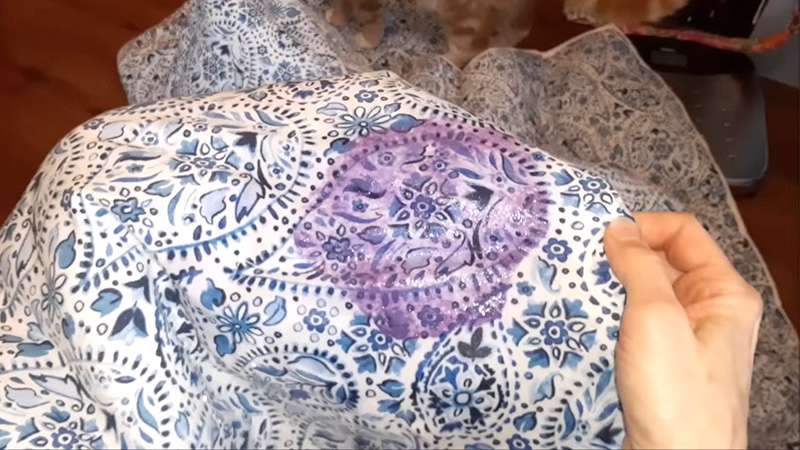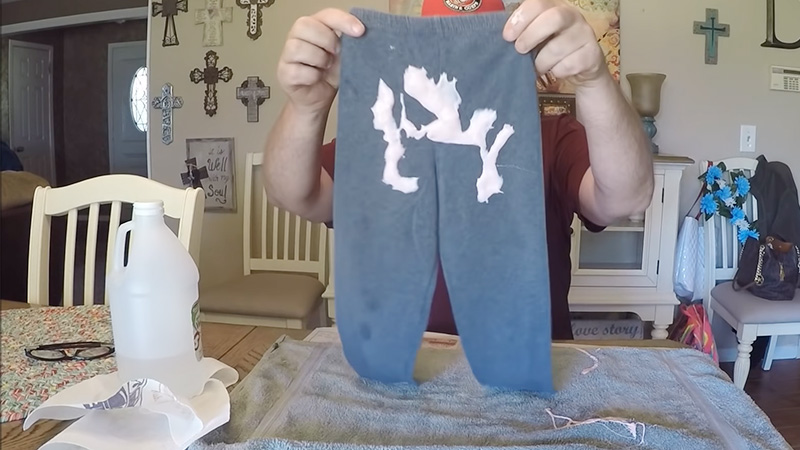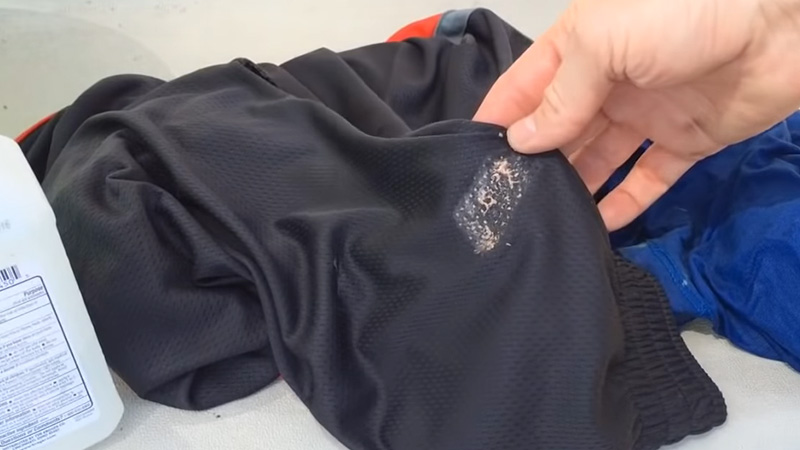Slime, the gooey and captivating playtime favorite, has a knack for finding its way onto fabrics, leaving behind stubborn stains. Whether it’s a child’s creative experiment or an accidental mishap, the challenge of removing slime from fabric can be daunting.
However, fear not, as there are effective methods to rescue your cherished textiles from the clutches of slime. In this guide, we will explore various techniques and materials that can help you bid farewell to these unwelcome stains.
Each method is accompanied by clear instructions and insights to ensure you can choose the most suitable approach for your fabric type and slime situation.
By the end of this guide, you’ll be armed with the knowledge and confidence needed on how to get slime out of fabric and restore your fabrics to their pristine state.

How To Get Slime Out Of Fabric?
Here are the simple methods to get slime out of fabric:
Freezing Method:
Place the fabric with the slime in the freezer. Once the slime is frozen, carefully scrape off as much as possible with a dull knife or a spoon.
Be gentle to avoid damaging the fabric. This method works because freezing makes the slime less sticky and easier to remove.
Vinegar Solution:
Mix equal parts of white vinegar and water. Dab the solution onto the slime stain using a clean cloth or sponge. Allow it to sit for a few minutes to loosen the slime. Gently blot and scrape the slime away.
Rinse with cold water and launder as usual. Vinegar is effective at breaking down the slime’s stickiness.
Rubbing Alcohol:
Apply a small amount of rubbing alcohol to a clean cloth or cotton ball and blot the slime stain. Gently rub in a circular motion to lift the slime off the fabric.
Rinse with cold water and wash as usual. Alcohol helps dissolve the slime, making it easier to remove.
Liquid Dish Soap:
Mix a few drops of liquid dish soap with warm water. Dab the solution onto the slime stain and gently rub the fabric together. Rinse with cold water and launder as usual. Dish soap is a mild detergent that can help break down the slime’s components.
Hot Water Soak:
Boil a pot of water and carefully pour it over the slime stain from a height of about a foot. The heat can soften the slime. Use a dull knife or spoon to gently scrape away the softened slime. Follow up with a stain remover or laundry detergent before washing.
Lemon Juice:
Squeeze fresh lemon juice onto the slime stain. Allow it to sit for a few minutes to break down the slime’s stickiness. Blot and scrape away the slime with a cloth or sponge. Rinse with cold water and launder as usual. Lemon juice contains natural acids that can help dissolve slime.
Commercial Stain Remover:
Use a commercial stain remover designed for protein-based stains like slime. Follow the product’s instructions for application and let it sit for the recommended time.
Then, launder the fabric as usual. Stain removers are formulated to break down tough stains effectively.
Remember to always check the care label on your fabric and follow the manufacturer’s instructions. Additionally, perform a spot test in an inconspicuous area to ensure the chosen method won’t harm or discolor the fabric.
Patience and gentle techniques are key to successfully removing slime from fabric without causing damage.
Which Materials Work To Get Slime Out Of Fabric?

Here’s a table listing the materials you’ll need for getting slime out of fabric:
| Material | Description |
| Butter knife or spoon | Used to gently scrape off excess slime. |
| Paper towels | To blot and remove excess slime residue. |
| White vinegar | A common household item for stain removal. |
| Liquid dish soap | Helps break down slime and stains. |
| Warm water | Used for mixing with vinegar and dish soap. |
| Old toothbrush | To scrub and agitate the stain gently. |
| Washcloth or sponge | For applying the cleaning solution and scrubbing. |
| Rubbing alcohol | Effective for dissolving slime and removing stains. |
| Glycerin (optional) | Can be used to soften and loosen dried slime. |
| Laundry detergent | For washing the fabric after stain removal. |
Please note that the effectiveness of these materials may vary depending on the type of fabric and the age of the slime stain. Always check the care label of the fabric and perform a spot test before applying any cleaning solution to ensure it won’t cause damage or discoloration.
How To Prevent Slime Stains?

Preventing slime stains can save you the hassle of having to remove them later. Here are the prevention tips:
Designate a Slime Area
Create a designated area for playing with slime, such as a table covered with a disposable tablecloth or a play mat. This keeps the slime contained and away from fabrics, reducing the risk of accidental spills.
Use Aprons and Disposable Gloves
Have children wear aprons and disposable gloves when playing with slime. This protective gear can help prevent slime from coming into contact with clothing and skin, reducing the chances of stains.
Set Clear Rules
Establish clear rules for slime play, emphasizing the importance of keeping slime away from carpets, upholstered furniture, and clothing. Educate children on the potential consequences of not following these rules.
Supervision and Assistance
Supervise younger children while they play with slime and provide assistance as needed. Promptly address any spills or accidents to minimize contact with fabric surfaces.
Store slime Properly
Store slime in airtight containers when not in use. Ensure that containers are sealed securely to prevent leakage and accidental spills that could lead to stains.
Choose Slime Recipes Wisely
Opt for slime recipes that use non-staining ingredients. Avoid colored dyes or glitter that may be prone to staining fabrics. Choose clear or white glue-based slimes to reduce the risk of color transfer.
Educate and Practice Clean-Up
Teach children the importance of responsible clean-up after slime play. Encourage them to wash their hands thoroughly and clean any surfaces that may have come into contact with slime immediately.
Having cleanup materials readily available, such as wet wipes and paper towels, can make this process easier.
By implementing these prevention tips, you can minimize the likelihood of slime stains on fabrics and surfaces, ensuring a more enjoyable and stress-free slime play experience.
What Are Some Slime Rules?
Here are some essential slime rules:
Wash Hands Before and After
Always start by washing your hands thoroughly before and after playing with slime. This rule helps prevent the transfer of dirt, germs, or any contaminants into the slime and ensures that your hands stay clean afterward.
Keep It Away from Eyes and Mouth
Slime should never come into contact with your eyes or mouth. Avoid any temptation to touch your face while handling slime.
This rule is crucial to prevent accidental ingestion or eye irritation, as some slime ingredients may not be safe for consumption or contact with sensitive areas.
Use Safe Ingredients
Ensure that you use safe, non-toxic ingredients when making slime. Read labels carefully, especially if you’re using colorants or additives. Avoid harmful chemicals and opt for kid-friendly, food-grade ingredients to make your slime creations.
Play on a Designated Surface
Limit slime play to a designated surface or area, such as a table with a disposable tablecloth or a designated play mat. This containment helps prevent accidental spills onto carpets, furniture, or other surfaces, which can be difficult to clean.
Avoid Fabric Contact
Keep slime away from clothing, upholstery, and other fabrics. Slime can be challenging to remove from fabrics once it dries. If possible, use aprons, play in old clothes, or follow strict rules to prevent accidental fabric contact.
Proper Storage
When not in use, store slime in airtight containers or resealable bags to prevent drying out or contamination. Proper storage also ensures that your slime remains usable for longer periods.
Clean Up After Play
Responsible cleanup is essential. Promptly clean any surfaces that come into contact with slime and wash hands thoroughly. Be diligent about returning slime and supplies to their designated storage to maintain a tidy and organized play area.
These slime rules promote safety, cleanliness, and responsible play, ensuring that slime remains a fun and enjoyable activity for everyone involved while minimizing potential risks and messes.
FAQs
How do I remove slime from fabric if it’s already dried and set in?
Removing dried and set-in slime from fabric can be more challenging, but it’s still possible. Start by scraping off as much dried slime as you can using a dull knife or spoon.
Can I use hot water to remove slime from the fabric?
While hot water can help soften slime for easier removal, it’s essential to check the fabric’s care label. Some fabrics are sensitive to hot water and may shrink or get damaged.
Is vinegar safe to use on all fabrics to remove slime?
Vinegar is generally safe for many fabrics, but it’s essential to perform a spot test in an inconspicuous area first. Some delicate fabrics may not react well to vinegar.
If your fabric passes the spot test, you can use a vinegar solution (equal parts vinegar and water) to help remove slime stains effectively.
Can I use bleach to remove slime stains from white fabrics?
While bleach can be effective for removing some stains, it’s generally not recommended for slime stains, especially on colored fabrics. Bleach can damage the fabric or cause color fading.
Are there any preventive measures to avoid slime stains on fabric?
Yes, there are preventive measures. Designate a slime play area with a disposable tablecloth, encourage children to wear aprons and gloves, set clear rules about where slime can be used, and educate them on responsible cleanup.
Conclusion
In the battle against slime stains on fabric, you now possess a formidable arsenal of techniques and materials to emerge victorious. Whether you choose the freezing method for its simplicity, the vinegar solution for its natural effectiveness, or commercial stain removers for stubborn stains, the key lies in prompt action and gentle treatment.
Remember to always check fabric care labels and perform spot tests before attempting any cleaning method. Patience and careful handling are essential to prevent damage to your cherished textiles.
With these strategies at your disposal, slime stains need not be a source of frustration. Instead, they become minor inconveniences easily remedied, allowing you to enjoy the creative and playful world of slime without worrying about its aftermath on your fabrics.
Leave a Reply